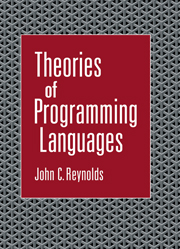Book contents
- Frontmatter
- Contents
- Preface
- 1 Predicate Logic
- 2 The Simple Imperative Language
- 3 Program Specifications and Their Proofs
- 4 Arrays
- 5 Failure, Input-Output, and Continuations
- 6 Transition Semantics
- 7 Nondeterminism and Guarded Commands
- 8 Shared-Variable Concurrency
- 9 Communicating Sequential Processes
- 10 The Lambda Calculus
- 11 An Eager Functional Language
- 12 Continuations in a Functional Language
- 13 Iswim-like Languages
- 14 A Normal-Order Language
- 15 The Simple Type System
- 16 Subtypes and Intersection Types
- 17 Polymorphism
- 18 Module Specification
- 19 Algol-like Languages
- Appendix: Mathematical Background
- Bibliography
- Index
12 - Continuations in a Functional Language
Published online by Cambridge University Press: 28 January 2010
- Frontmatter
- Contents
- Preface
- 1 Predicate Logic
- 2 The Simple Imperative Language
- 3 Program Specifications and Their Proofs
- 4 Arrays
- 5 Failure, Input-Output, and Continuations
- 6 Transition Semantics
- 7 Nondeterminism and Guarded Commands
- 8 Shared-Variable Concurrency
- 9 Communicating Sequential Processes
- 10 The Lambda Calculus
- 11 An Eager Functional Language
- 12 Continuations in a Functional Language
- 13 Iswim-like Languages
- 14 A Normal-Order Language
- 15 The Simple Type System
- 16 Subtypes and Intersection Types
- 17 Polymorphism
- 18 Module Specification
- 19 Algol-like Languages
- Appendix: Mathematical Background
- Bibliography
- Index
Summary
In this chapter, we introduce continuations into the setting of a functional language using eager evaluation. We begin by defining a continuation semantics for the language of the previous chapter. Next, we extend this language by introducing continuations as values. Finally, we derive a first-order semantics that reveals how one might implement the extended language interpretively.
Continuation Semantics
When the evaluation of an expression gives an error or fails to terminate, this “computational effect” is the final result of the entire program. In the direct denotational semantics of Section 11.6, this behavior is expressed by passing err, tyerr, or ⊥ through a chain of *-extended functions that preserve these results.
An alternative approach is to use a continuation semantics, similar to the one discussed in Section 5.7, in which the semantic function, when applied to an expression e, an environment η, and a new argument K called a continuation, produces the final result of the entire program in which e is embedded. If the evaluation of e gives a value, then the final result is obtained by applying K to this value; but if the evaluation gives an error stop or fails to terminate (or executes a throw operation, which we will discuss in the next section), this result is produced directly without using the continuation. This makes it immediately evident that the “rest of the computation”, which is represented by the continuation, has no effect on the final result. (We will use the metavariable K, with occasional primes and subscripts, for continuations.)
Information
- Type
- Chapter
- Information
- Theories of Programming Languages , pp. 251 - 272Publisher: Cambridge University PressPrint publication year: 1998
